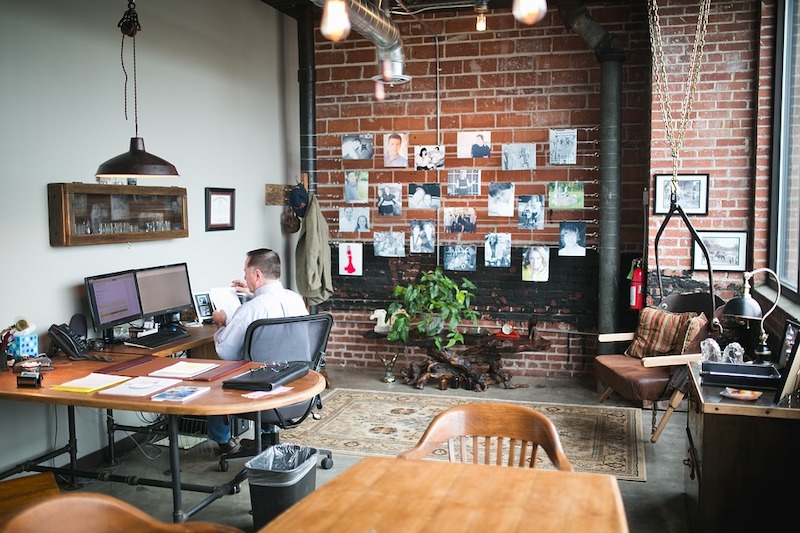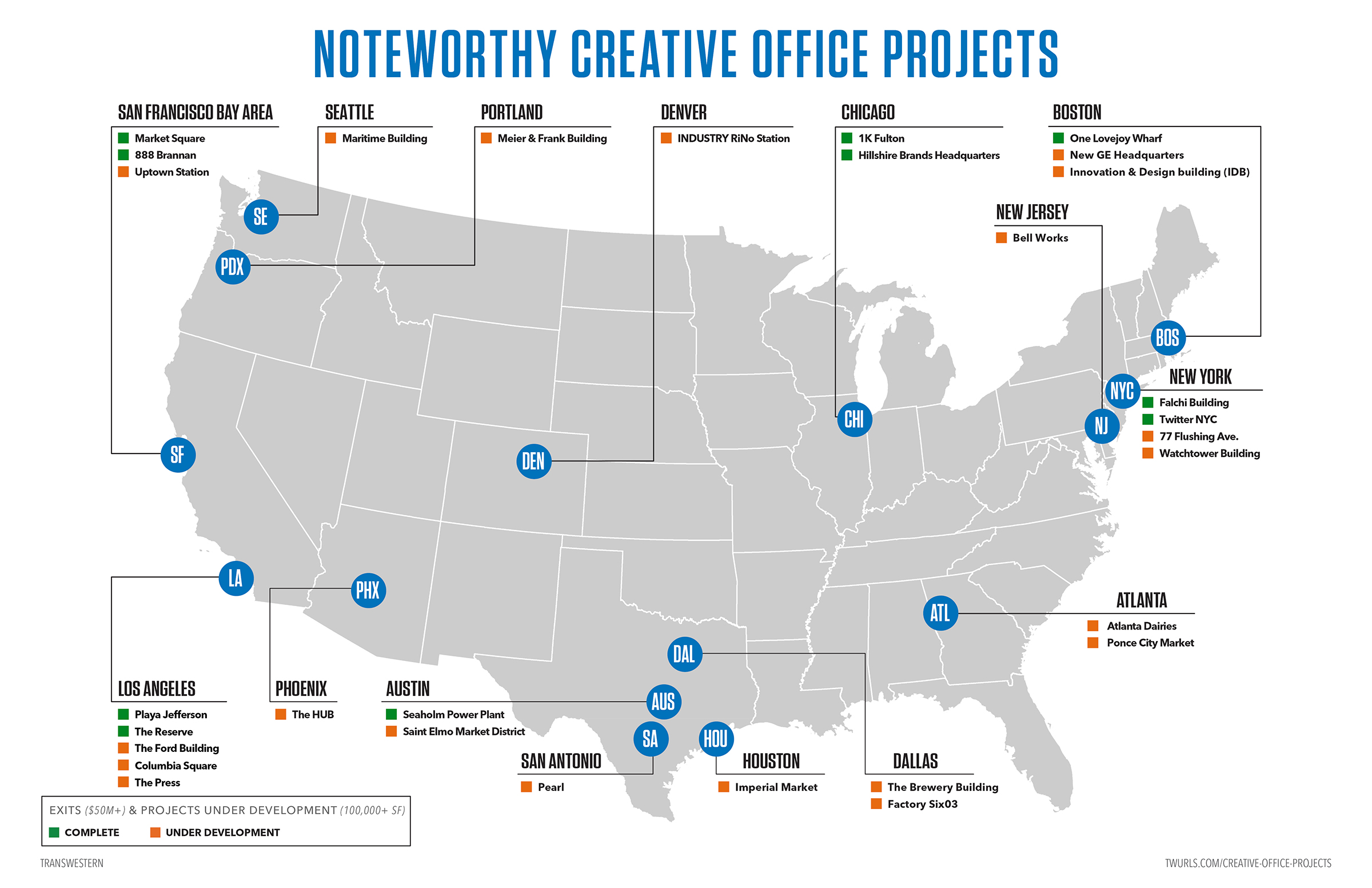Transwestern has released a report examining a number of creative office projects that have generated substantial returns for investors upon completion. The adaptive reuse developments span Boston, Chicago, Los Angeles, New York, Phoenix, San Francisco, and Austin, Texas. The report also highlights 20 additional large creative office projects currently underway across the country.
Michael Soto, Director of Research in Southern California and co-author of the report, explains that while creative office conversions are not new, what is different this cycle is the sheer volume of creative office exits nationally at core/core-plus pricing that have occurred during the past five years – with the buyers being major institutional investors or well-known owner/users.
“The conversion of a property from industrial or retail use to creative office has become an increasingly popular value-add strategy for investors,” Soto says in a release. “Two trends are fueling demand for this type of differentiated office product: One, technology, advertising, media and other companies trying to attract millennials are interested in the characteristic features of creative office space – open floor plans, natural lighting, common spaces and amenities such as cafés and rec rooms. And two, tenants are returning to cities, where they can take advantage of live/work/play environments.”
Based on favorable exit pricing of some major creative office projects around the country, this type of value-add strategy, on this large scale, is now being considered by developers, either via direct investment or joint-venture partnerships with equity partners. Conversely, stabilized creative office properties are on the radar of many national and international institutional buyers that are paying traditional trophy Class A pricing for these types of properties, usually based on the credit-worthiness of the tenant, as well as the location of the project.
The report cautions, however, that many of these projects were acquired and developed under very different economic conditions than exist today.
“Rising land, building and construction costs – especially in hot neighborhoods – may add more risk when compared to a few years ago, when we were at a different point in the real estate cycle,” said Sandy McDonald, Director of Research in Chicago and co-author of the report. “In addition, adaptive reuse often comes with hidden costs and potentially expensive future property modifications.”
Moreover, the popularity of the creative office concept means that there is more inventory in the market today. Landlords that own existing office buildings or are doing ground-up development are realizing that they must consider strategic property enhancements and creative office-associated tenant amenities to stay competitive in the marketplace.
To view the complete report, titled Creative Office Projects: Adaptive Reuse Generates Staggering Returns for Investors, click here.
Related Stories
| Aug 11, 2010
AIA Course: Enclosure strategies for better buildings
Sustainability and energy efficiency depend not only on the overall design but also on the building's enclosure system. Whether it's via better air-infiltration control, thermal insulation, and moisture control, or more advanced strategies such as active façades with automated shading and venting or novel enclosure types such as double walls, Building Teams are delivering more efficient, better performing, and healthier building enclosures.
| Aug 11, 2010
Glass Wall Systems Open Up Closed Spaces
Sectioning off large open spaces without making everything feel closed off was the challenge faced by two very different projects—one an upscale food market in Napa Valley, the other a corporate office in Southern California. Movable glass wall systems proved to be the solution in both projects.
| Aug 11, 2010
Silver Award: Pere Marquette Depot Bay City, Mich.
For 38 years, the Pere Marquette Depot sat boarded up, broken down, and fire damaged. The Prairie-style building, with its distinctive orange iron-brick walls, was once the elegant Bay City, Mich., train station. The facility, which opened in 1904, served the Flint and Pere Marquette Railroad Company when the area was the epicenter of lumber processing for the shipbuilding and kit homebuilding ...
| Aug 11, 2010
Special Recognition: Durrant Group Headquarters, Dubuque, Iowa
Architecture firm Durrant Group used the redesign of its $3.7 million headquarters building as a way to showcase the firm's creativity, design talent, and technical expertise as well as to create a laboratory for experimentation and education. The Dubuque, Iowa, firm's stated desire was to set a high sustainability standard for both itself and its clients by recycling a 22,890-sf downtown buil...
| Aug 11, 2010
Thrown For a Loop in China
While the Bird's Nest and Water Cube captured all the TV coverage during the Beijing Olympics in August, the Rem Koolhaas-designed CCTV Headquarters in Beijing—known as the “Drunken Towers” or “Big Shorts,” for its unusual shape—is certain to steal the show when it opens next year.
| Aug 11, 2010
Top of the rock—Observation deck at Rockefeller Center
Opened in 1933, the observation deck at Rockefeller Center was designed to evoke the elegant promenades found on the period's luxury transatlantic liners—only with views of the city's skyline instead of the ocean. In 1986 this cultural landmark was closed to the public and sat unused for almost two decades.
| Aug 11, 2010
200 Fillmore
Built in 1963, the 32,000-sf 200 Fillmore building in Denver housed office and retail in a drab, outdated, and energy-splurging shell—a “style” made doubly disastrous by 200 Fillmore's function as the backdrop for a popular public plaza and outdoor café called “The Beach.
| Aug 11, 2010
Integrated Project Delivery builds a brave, new BIM world
Three-dimensional information, such as that provided by building information modeling, allows all members of the Building Team to visualize the many components of a project and how they work together. BIM and other 3D tools convey the idea and intent of the designer to the entire Building Team and lay the groundwork for integrated project delivery.
| Aug 11, 2010
Inspiring Offices: Office Design That Drives Creativity
Office design has always been linked to productivity—how many workers can be reasonably squeezed into a given space—but why isn’t it more frequently linked to creativity? “In general, I don’t think enough people link the design of space to business outcome,” says Janice Linster, partner with the Minneapolis design firm Studio Hive.
| Aug 11, 2010
Great Solutions: Products
14. Mod Pod A Nod to Flex Biz Designed by the British firm Tate + Hindle, the OfficePOD is a flexible office space that can be installed, well, just about anywhere, indoors or out. The self-contained modular units measure about seven feet square and are designed to serve as dedicated space for employees who work from home or other remote locations.








